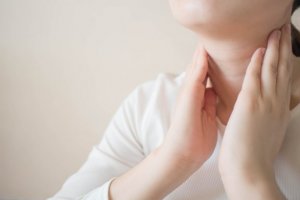Could You Have Vocal Cord Nodes or Polyps?

Vocal cord nodes or polyps are considered frequent larynx injuries. They grow organically as benign bulges on the edges of the cords. The injuries may have various causes. In most cases, the characteristics, diagnosis, and treatment are quite similar.
Nodes are primarily caused by “misuse” of the vocal cords. People who strain their voices while singing may experience polyps and nodes on their vocal cords. The same goes for teachers in classes with many students who strain to make themselves heard.
People at risk for vocal cord nodes or polyps
First of all, all people who use their voices for their work are at risk of developing vocal cord nodes and polyps – from phone operators, singers, actors, public speakers, and teachers to street vendors.
Even people with mild hearing loss can develop the habit of speaking too loudly, leading to damage. Anything that involves straining your voice can lead to nodes and polyps.

Symptoms that indicate the presence of vocal cord nodes or polyps
The most common symptom is vocal fatigue and a whole range of signs that can be heard when talking. The voice becomes broken and hoarse.
Additionally, there may be a lack of air when exhaling which makes medium or long sentences impossible. In these cases, there may be chronic dysphonia.
Additionally, the presence of inflammation can lead to coughing, sore throat, muscle tension in the neck, discomfort, and even pain. A good ENT specialist can diagnose the severity of the case. From there, you can follow the appropriate treatment.
Evaluating and diagnosing vocal cord nodes and polyps
Often, you may find you have a hoarse voice after an intense work day, which later goes away. When should you see a doctor to know whether there is any damage to your vocal cords?
In reality, the hoarseness needs to persist for more than two or three weeks for it to be cause for alarm.
If a checkup is necessary, your doctor will evaluate the level of hoarseness, or dysphonia through various procedures. The first is an analysis of your voice quality. A speech pathologist will be able to tell, based on the type of hoarseness, whether you need treatment or not.
The second procedure is direct observation, or a laryngoscope. To do this, the doctor will use a mirror or laryngoscope. The doctor may also notice signals that require a biopsy. The biopsy is performed, if necessary, to rule out any possible carcinomas. In these cases, the study is called a microlaryngoscopy.

Common treatments for vocal cord polyps and nodes
Surgical interventions are the last resort for this type of injury. Only if the throat afflictions are very large and have been present for a long time will they need to be removed surgically. Rather, they’ll try to determine the main causes of the vocal cord polyps or nodes.
Whether it’s a glandular problem (hyperthyroidism), gastric (reflux), or allergic, an ENT specialist will refer patients to the appropriate specialists. On the other hand, the most effective treatment to relieve, prevent, and cure vocal cord nodes and polyps is voice training.
Vocal cord nodes or polyps are considered frequent larynx injuries. They grow organically as benign bulges on the edges of the cords. The injuries may have various causes. In most cases, the characteristics, diagnosis, and treatment are quite similar.
Nodes are primarily caused by “misuse” of the vocal cords. People who strain their voices while singing may experience polyps and nodes on their vocal cords. The same goes for teachers in classes with many students who strain to make themselves heard.
People at risk for vocal cord nodes or polyps
First of all, all people who use their voices for their work are at risk of developing vocal cord nodes and polyps – from phone operators, singers, actors, public speakers, and teachers to street vendors.
Even people with mild hearing loss can develop the habit of speaking too loudly, leading to damage. Anything that involves straining your voice can lead to nodes and polyps.

Symptoms that indicate the presence of vocal cord nodes or polyps
The most common symptom is vocal fatigue and a whole range of signs that can be heard when talking. The voice becomes broken and hoarse.
Additionally, there may be a lack of air when exhaling which makes medium or long sentences impossible. In these cases, there may be chronic dysphonia.
Additionally, the presence of inflammation can lead to coughing, sore throat, muscle tension in the neck, discomfort, and even pain. A good ENT specialist can diagnose the severity of the case. From there, you can follow the appropriate treatment.
Evaluating and diagnosing vocal cord nodes and polyps
Often, you may find you have a hoarse voice after an intense work day, which later goes away. When should you see a doctor to know whether there is any damage to your vocal cords?
In reality, the hoarseness needs to persist for more than two or three weeks for it to be cause for alarm.
If a checkup is necessary, your doctor will evaluate the level of hoarseness, or dysphonia through various procedures. The first is an analysis of your voice quality. A speech pathologist will be able to tell, based on the type of hoarseness, whether you need treatment or not.
The second procedure is direct observation, or a laryngoscope. To do this, the doctor will use a mirror or laryngoscope. The doctor may also notice signals that require a biopsy. The biopsy is performed, if necessary, to rule out any possible carcinomas. In these cases, the study is called a microlaryngoscopy.

Common treatments for vocal cord polyps and nodes
Surgical interventions are the last resort for this type of injury. Only if the throat afflictions are very large and have been present for a long time will they need to be removed surgically. Rather, they’ll try to determine the main causes of the vocal cord polyps or nodes.
Whether it’s a glandular problem (hyperthyroidism), gastric (reflux), or allergic, an ENT specialist will refer patients to the appropriate specialists. On the other hand, the most effective treatment to relieve, prevent, and cure vocal cord nodes and polyps is voice training.
All cited sources were thoroughly reviewed by our team to ensure their quality, reliability, currency, and validity. The bibliography of this article was considered reliable and of academic or scientific accuracy.
- seorl.net. Nódulos vocales. Extraído de: http://seorl.net/wp-content/uploads/2015/09/Anexo-6-N%C3%B3dulos.pdf
- neumologia-pediatrica. (2014). Evaluación y diagnóstico de la disfonía en niños. Extraído de: http://www.neumologia-pediatrica.cl/wp-content/uploads/2017/06/evaluacion-diagnostico-disfonia-ninos.pdf
This text is provided for informational purposes only and does not replace consultation with a professional. If in doubt, consult your specialist.








